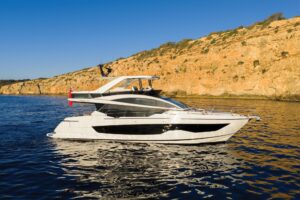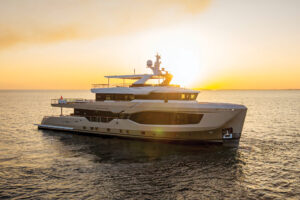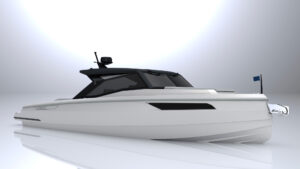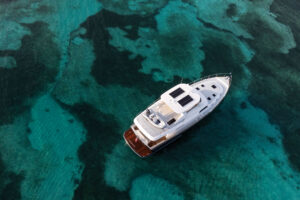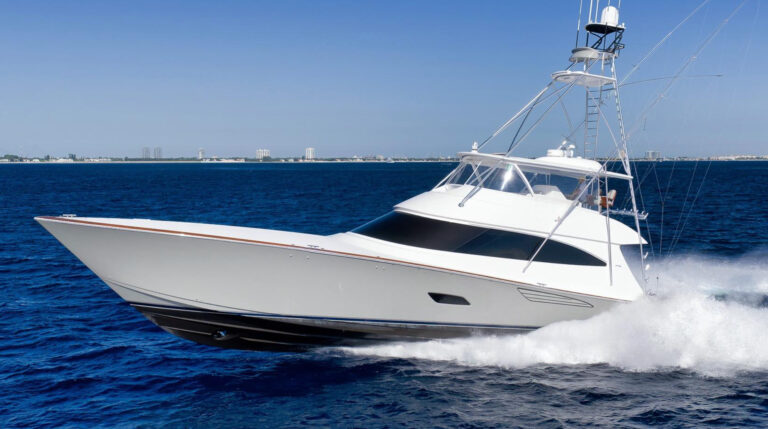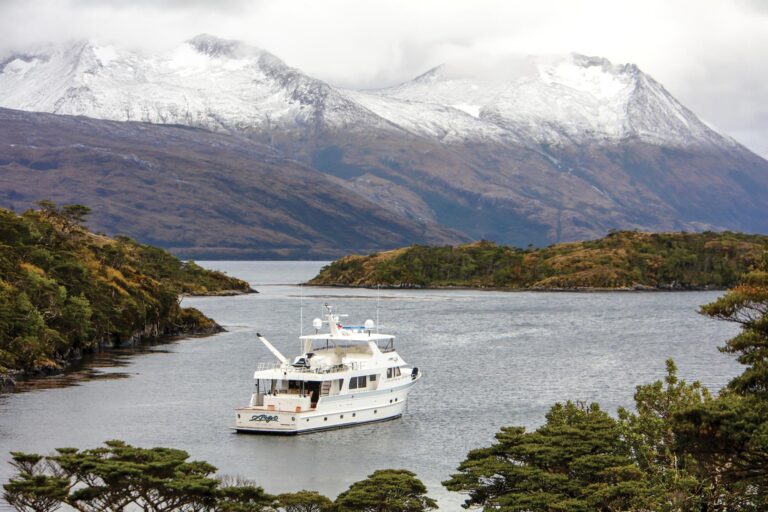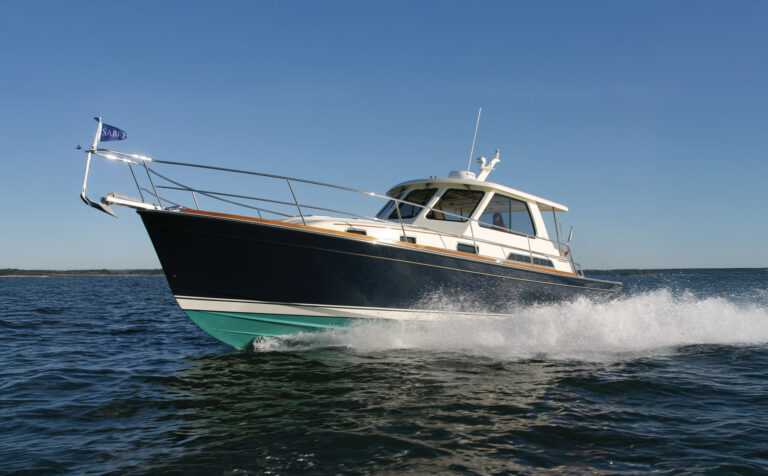
Maritimo M53
Top-notch engine room? Check. Easy to service mechanical systems? Check. Unobstructed sight lines? Check. Quality construction? Check. Cruiser friendly interior? Check. Efficient and seakindly ride? Check.
The list goes on. In fact, the more time I spent on the new Maritimo M53 Motoryacht, the more I realized that this cruiser ticks off all the boxes required of a boat designed and built to cruise well beyond the marina. In fact, of all the Maritimo models introduced at the last Sanctuary Cove Boat Show on Australia’s Gold Coast, the M53 stood out, in my opinion (see the complete photo gallery here).
Why? Well, for starters the no-nonsense cruiser remains true to founder Bill Barry-Cotter’s original mission of building practical, easy to maintain boats that won’t let you down when the conditions turn snotty.
An overarching thread of this philosophy is design simplicity. These days, it takes only a few minutes of talking with fellow boaters before the topic turns to how complicated boating has become. Yet Maritimo has perfected its formula to allow the owner/operator more time on the water, and less time spent poring over manuals trying to figure out how to turn on the television. For instance, the single 1,017-gallon fiberglass fuel tank means an absence of a fuel manifold system and/or transfer pump, not to mention a concentration of weight at the center of gravity. Fewer moving parts equals less maintenance. The electrical system is straightforward, with two starting banks and a separate house bank. A 1,200-watt inverter and 17.5 kW Onan generator provide alternating current service. All wiring is neatly run and precisely labeled, and the engine room is superbly laid out in trademark Maritimo fashion, allowing access to all components.
If you have yet to run a Maritimo offshore, I urge you to do so. The length-to-beam ratio of 3.5 for the M53 is about normal, not too fat and not too slender. Barry-Cotter is adamant about ensuring his boats have a relatively shallow shaft angle, in this case nine degrees. Not only can this help optimize thrust, but it also can help reduce vibration, thanks to a steadier load being applied to the propeller blades. We rose easily out of the hole, without touching the trim tabs, and achieved plane at an optimum running angle of approximately 5 degrees with slight tab applied. The 715-horsepower Volvo D12 diesels were well suited for the M53 and propelled us to a top speed of 32.2 knots. (The new 800-horsepower D13 replaces the D12.) American boaters, take note: There is no need to cram in the largest engine possible to gain an extra knot, a practice that causes Barry-Cotter to roll his eyes. Pull the throttles back to 1800 rpm and cruise all day long at 22 knots while burning a total of 40 gallons per hour. As happens in all Maritimos, headseas were met with ease and no pounding.
The 59,600-pound displacement is also right on the money for this boat, and keeping the weight in check adds to the efficiency. The bottom is solid glass, while the topsides, deck, deckhouse and enclosed bridge are cored.
I admit I’ve become a fan of the enclosed bridge layout. Maritimo certainly is leading the charge in this area in the under-60-foot market. The builder does a superb job of incorporating plenty of light and breezes via a sunroof, side windows and aft opening doors. You can enjoy the salt air and ocean smells, yet still seal up if the weather dictates. The advantages of an enclosed bridge were evident during a night cruise on the M56 a few years ago. We were safe, warm and secure, with a clear line of sight, yet could easily traverse the stairs to the lower deck and check on guests in the salon.
Even with seven people on the bridge during the M53 sea trial, everyone was more than comfortable. The line of sight is unflawed. The two unobstructed walkways from the cockpit through the transom allow the helmsman to easily view the large swim platform while backing down. Side windows allow communication with line handlers on deck.
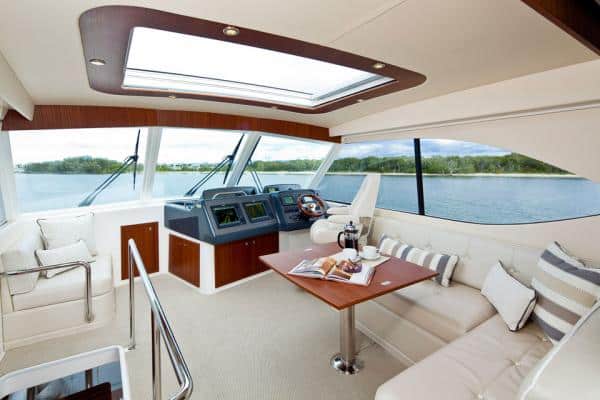
As with every Maritimo, a lot of thought is given to the design of the helm — a direct result of Barry-Cotter and the company’s offshore powerboat racing pedigree. I like the fact that a mate can easily access the electronics and multifunction display. If you’ve ever navigated a busy harbor or run at night, you’ll understand the importance of a setup that allows the helmsman to drive and the companion to navigate.
Abaft the helm lies a settee with a teak table and a wet bar with refrigerator. This is a fantastic bonus area and will easily serve as a second salon. Sliding glass doors access the small deck that also shelters the entrance to the salon below. Thanks to this deck, the enclosed bridge, the foredeck and the cockpit, there is no shortage of areas in which to socialize.
Our test M53 revealed an updated Maritimo interior scheme designed by David Stewart. The details jazzed up the whole package, while still remaining on brand. The builder avoids flashy treatments, preferring more timeless design elements that will still look good 20 years from now. Our test boat featured Maritimo’s trademark aft galley. It’s one of those items that lead you to question why it took so long for production builders to embrace the concept. A sliding, three-panel glass-and-aluminum door allows a seamless transition to the cockpit. An island with additional stowage is a nice touch, and the full-height pantry is huge.
Opposite to port is a three-quarter-height refrigerator and freezer unit, along with the electrical panel. It’s so refreshing to see a properly arranged electrical panel at eye level that doesn’t require you to stand on your head and pirouette to turn on the lights. A Fisher & Paykel four-burner cooktop, a dishwasher and a Panasonic microwave complete this cook-friendly galley.
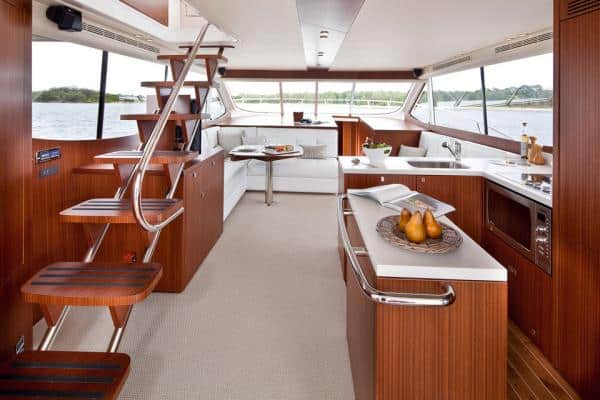
Large gatherings are easily accommodated in the salon, where an L-shape settee with table to port and a straight settee to starboard serve nicely. The lower deck features three staterooms and two heads. It’s a toss-up when deciding which to choose as the master stateroom. Though the amidships stateroom with island berth, large opening window and en suite head is designated as the master by the builder, the forward stateroom with an island berth and abundant natural light and stowage and a shared head would be my choice. A single-berth cabin is starboard and would make a fine snore box or guest accommodations.
Cruiser friendly touches continue in the cockpit with details like freshwater and saltwater washdowns, additional stowage and a fiberglass unit across the transom that houses an optional barbecue. Side decks are wide, and the high gunwale is a smart detail.
With so many new Maritimo models introduced in the past 24 months, it was refreshing to see that the builder hasn’t forgotten the type of boat that launched its success. If you’re in the market for a stout performance cruiser, make sure the M53 is on your list.
LOA: 57’8″
BEAM: 17’1″
DRAFT: 4’5″
DISPL.: 59,600 lb.
FUEL: 1,017 gal.
WATER: 211 gal.
ENGINE OPTIONS: 2 x 715 hp Cummins QSM 11 diesels; 2 x 800 hp Volvo D13 diesels
ENGINES TESTED: 2 x 715 hp Volvo D12 diesels
BASE PRICE: $1,655,500
Maritimo, 206-462-6080; www.maritimousa.com
Test conditions: Speeds were measured by GPS in the Coral Sea, with gradual swells and light winds, with ½ load of fuel and water and seven people on board. Fuel consumption was calculated by the electronic engine-monitoring system. Sound levels were measured at the helm.
RPM Knots GPH dB(A)
900 9.2 6.7 60
1200 10.2 16.0 63
1500 16.3 27.0 65
1800 22.0 40.0 68
2100 28.2 54.1 72
2370 32.2 75.0 76

